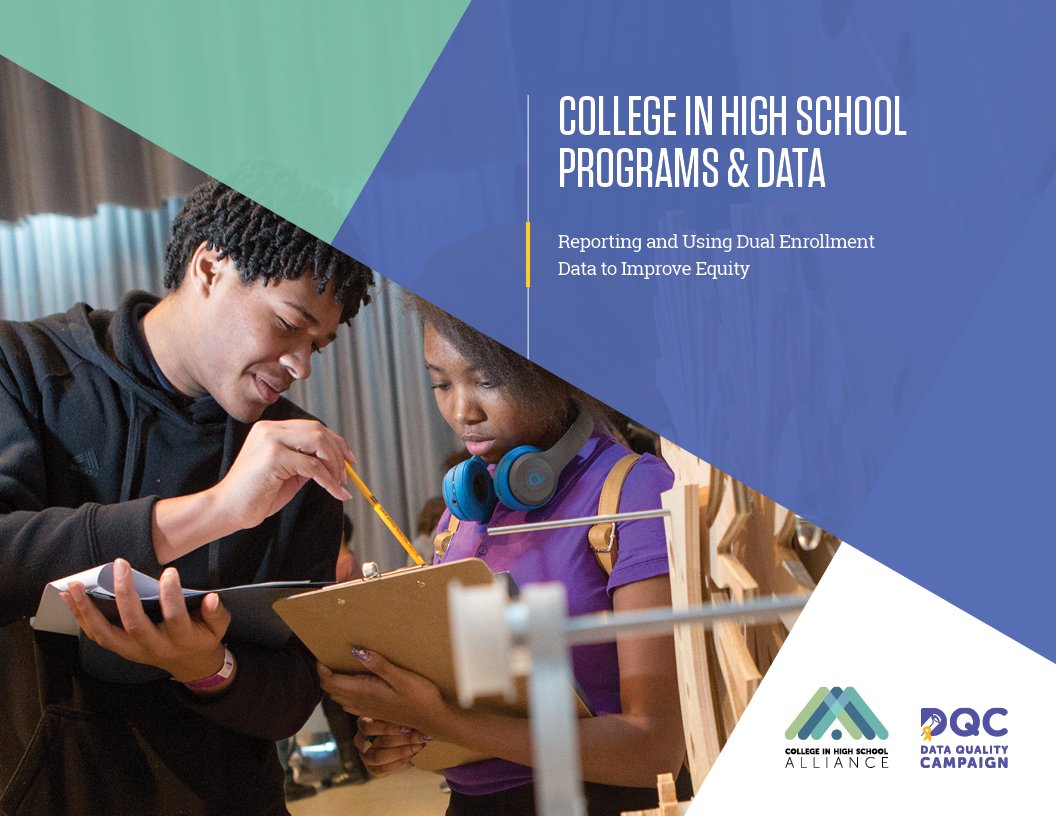College in High School Programs & Data: Reporting and Using Dual Enrollment Data to Improve Equity
Using Data to Drive Equity in Dual Enrollment
November, 2021
Access to high-quality college in high school programs—such as dual enrollment, concurrent enrollment, and early college—can change a student’s life. But to make these opportunities equitable, states must first understand who has access and who is being left behind, and to do that we need dual enrollment data.
That’s the focus of College in High School Programs & Data: Reporting and Using Dual Enrollment Data to Improve Equity, a new resource from the College in High School Alliance (CHSA) and the Data Quality Campaign (DQC). The guide outlines how states can collect, report, and use disaggregated data on participation and outcomes in dual enrollment programs to close persistent equity gaps and strengthen accountability for results.
Why Dual Enrollment Data Matters
College in high school programs consistently increase high school graduation, college enrollment, persistence, and completion rates—especially for students from low-income backgrounds, students of color, and first-generation college students.
However, access to these opportunities remains unequal, and too often states lack comprehensive data to identify or address disparities. The report calls for states to:
-
Set statewide equity goals for dual enrollment participation and success.
-
Collect disaggregated data by race, income, disability status, English learner status, and more.
-
Publicly report outcomes so policymakers, schools, and families can hold systems accountable for improvement.
-
Use the data to inform action, ensuring that every student—no matter their background—can benefit from early college experiences.
A Three-Phase Framework for States
The CHSA–DQC framework helps states build comprehensive, transparent data systems that serve all stakeholders:
-
Ask the Right Questions
Clarify the purpose, audience, and use of dual enrollment data. -
Collect and Report the Right Data
Standardize definitions, disaggregate by key demographics, and include success measures—not just access. -
Use the Data to Drive Change
Engage policymakers, institutions, and communities to turn data into action that expands equity and opportunity.
Profiles in Progress
The report highlights leading examples from Colorado, Hawaii, Indiana, Louisiana, Kentucky, and Washington, showing how state data reporting can directly inform policy reform, improve student outcomes, and build more inclusive dual enrollment systems.
College in high school programs—such as dual enrollment, concurrent enrollment, and early college high school—provide significant benefits to students, including increased rates of college access and success.
To support increased college access and success for students through dual enrollment, states, school districts, and colleges must collect, publicly report, and use data on participation and success in these opportunities.
The paper is designed to help states - as well as colleges and school districts - understand what data on dual enrollment access and success they should collect and report, and how that data can be used to close equity gaps and improve student outcomes. The report provides examples of existing state dual enrollment reporting mechanisms and how they are being used to close equity gaps.
The report includes:
-
Why reporting of data for dual enrollment by states matters,
-
The primary approaches to reporting dual enrollment data,
-
How to improve dual enrollment data reporting,
-
Profiles of six states’ progress (Colorado, Hawaii, Indiana, Louisiana, Kentucky, and Washington), and
-
A compilation of all state-level data reporting.
Launch Webinar - November 2, 2021
On November 2, 2021 CHSA and DQC hosted a webinar with state leaders to discuss the report and its findings.



